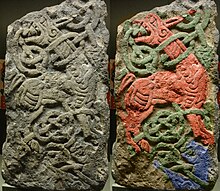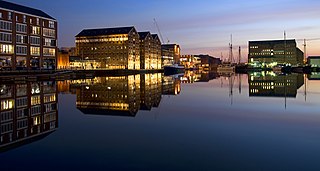
Gloucester is a cathedral city and the county town of Gloucestershire in the South West of England. Gloucester lies on the River Severn, between the Cotswolds to the east and the Forest of Dean to the west; it is sited 19 miles (31 km) east of Monmouth and 17 miles (27 km) east of the border with Wales. Gloucester has a population of around 132,000, including suburban areas. It is a port, linked via the Gloucester and Sharpness Canal to the Severn Estuary.

Stroud is a market town and civil parish in Gloucestershire, England. It is the main town in Stroud District. The town's population was 13,500 in 2021.

George Wesley Bellows was an American realist painter, known for his bold depictions of urban life in New York City. He became, according to the Columbus Museum of Art, "the most acclaimed American artist of his generation".

Jannis Kounellis was a Greek Italian artist based in Rome. A key figure associated with Arte Povera, he studied at the Accademia di Belle Arti in Rome.
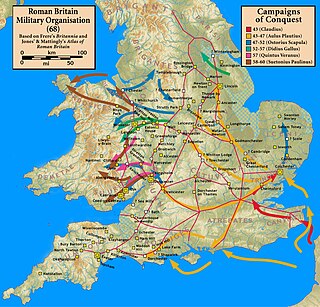
Glevum was originally a Roman fort in Roman Britain that became a "colonia" of retired legionaries in AD 97. Today, it is known as Gloucester, in the English county of Gloucestershire. The name Glevum is taken by many present-day businesses in the area and also by the 26-mile Glevum Way, a long-distance footpath or recreational walk encircling modern Gloucester.

Arlingham is a village and civil parish in the Stroud District of Gloucestershire, England. The 2021 Census recorded a parish population of 533. The parish contains the hamlets of Milton End, Overton and Priding. The next parish to the east is Fretherne with Saul.
Gloucester was, from 1894 to 1974, a rural district in the administrative county of Gloucestershire, England. The district did not include the City of Gloucester, which was a separate county borough. In 1935, Gloucester RD was more than doubled in size.

Gloucester Castle was a Norman-era royal castle situated in the city of Gloucester in Gloucestershire, England. It was demolished in 1787 and replaced by Gloucester Prison.

John Puhiatau Pule is a Niuean artist, novelist and poet. The Queensland Art Gallery describes him as "one of the Pacific's most significant artists".
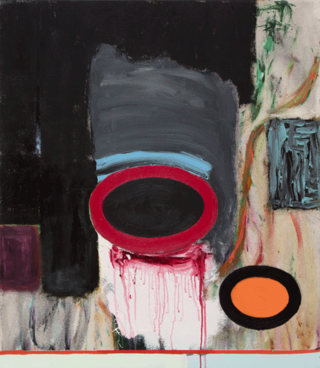
Pete Hoida artist and poet was born at Birkenhead in 1944 and died at his home in Brownshill near Stroud in 2023. He was an abstract artist committed to the modernist tradition. He ceased writing circa 1985, after which he dedicated his time wholly to painting. After a hiatus of 25 years he resumed writing and had poems published 2011–2016.

St Oswald's Priory was founded by Æthelflæd, daughter of Alfred the Great, and her husband Æthelred, ealdorman of Mercia, in the late 880s or the 890s. It appears to have been an exact copy of the Old Minster, Winchester It is a Grade I listed building.
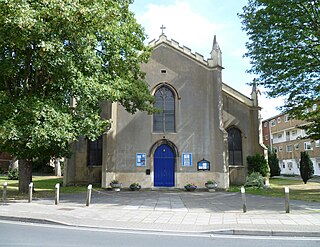
St Mary de Lode Church is a Church of England church immediately outside the grounds of Gloucester Cathedral. It is believed by some to be on the site of the first Christian church in Britain. The church is in the Diocese of Gloucester and Grade I listed by English Heritage. It has also been known as St. Mary Before the Gate of St. Peter, St. Mary Broad Gate and St. Mary De Port.
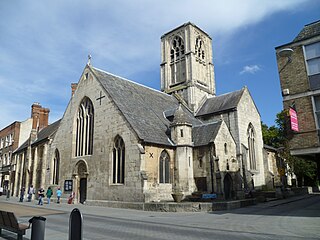
St Mary de Crypt Church, Southgate Street, Gloucester, is an Anglican Church, which was first recorded in 1140 as The Church of the Blessed Mary within Southgate. It is in the Diocese of Gloucester and is located adjacent to the ruins of Greyfriars. It has also been known as Christ Church and St. Mary in the South. St Mary de Crypt is a Grade I listed building.
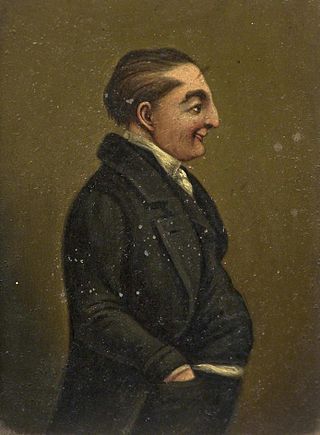
James "Jemmy" Wood was the owner of the Gloucester Old Bank who became nationally known as "The Gloucester Miser". His wealth of around £900,000 was stated at the time to have made him "the richest commoner in His Majesty's dominions".

The Gloucester Old Bank was a British bank that operated between 1716 and 1838. It was founded in 1716 by James Wood. The bank was said to have been the oldest private bank in Britain, having survived the financial consequences of the Napoleonic Wars when many other banks went out of business. The claim is wrong as both C. Hoare & Co. and Child & Co. were founded earlier; the Gloucester Old Bank was, however, one of the oldest banks in Britain in the nineteenth century.

Ladybellegate House, 20 Longsmith Street, Gloucester GL1 2HT, is a Grade I listed building with Historic England, reference number 1245726.

The Westgate area of Gloucester is centred on Westgate Street, one of the four main streets of Gloucester and one of the oldest parts of the city. The population of the Westgate ward in Gloucester was 6,687 at the time of the 2011 Census.
Carolyn Mary Heighway FSA is an archaeological consultant to Gloucester Cathedral and the owner, with her husband Richard Maurice Bryant, of Past Historic, a company which specialises in the design and production of archaeological books and journals as well as exhibitions. She was a founder trustee of Cotswold Archaeology in 1989, and is a fellow of the Society of Antiquaries of London. She is a former president of the Bristol and Gloucestershire Archaeological Society.

This is a bibliography of the City of Gloucester in the south-west of England. The city lies close to the Welsh border, on the River Severn, between the Cotswolds to the east and the Forest of Dean to the southwest. It was founded by the Romans under Emperor Nerva as Colonia Glevum Nervensis, and was granted its first charter in 1155 by King Henry II.
Elizabeth Gray, also known as Ben Venuto and Emmie Gee, was an artist specialising in sporting and wildlife pictures.

